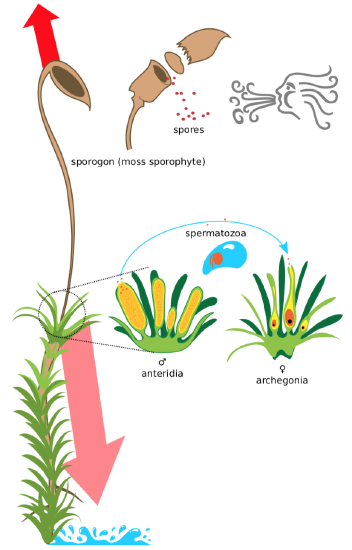6.1: Bryophyta - the Mosses
- Page ID
- 18011
Bryophyta has gametophyte predominance while Pteridophyta and Spermatophyta both have sporophyte predominance (and the main difference between Pteridophyta and Spermatophyta is that Spermatophyta has seeds). Bryophyta has approximately 20,000 species. They do not have roots, but have long dead cells capable of water absorbency via apoplastic transport, these cells are called rhizoid cells. Their sporophyte is reduced to sporogon, which is simply a sporangium with setamosses: stalk of the sporogon (see) (stalk), and is usually parasitic. Gametophyte of bryophytes starts its development from a protonema, thread of cells. Bryophyta are poikilohydric; they go through dehydration or extremely low water concentration without any serious physiological damage to the plant.

Life cycle of mosses is similar to the general life cycle of land plants described above. They begin with a gametophyte with an archegonia and antheridia. The antheridium produces biflagellate spermatozoa which fertilizes the egg and produces diploid zygote; zygote grows into a sporogon and its cells (mother cells of spores) go through meiosis which produces haploid spores. Spores will be distributed with the wind, land on the substrate and germinate into protonema stage which then develops into a green, well-developed gametophyte. Most of moss gametophytes have a shoot body that consists of a stem and leaves (but no roots) while others have a thallus body, which is a flat, leaf-like, and undifferentiated structure.
There are three main groups, also known as subphyla, of Bryophyta: Hepaticae (liverworts), Bryophytina (true mosses), and Anthocerotophytina (hornworts).
- Hepaticae are phylogenetically closest to green algae. Their thallus typically has dorsal and ventral parts, and the sporogon is bag-like. Inside the sporangium, there is no central column (columella) but elaters are present, which are cells that loosen spores. One of the most widespread liverwort is Marchantia, it is commonly found in wet shady places. It became a frequent weed in greenhouses.
- Bryophytina consists of multiple classes (Figure \(\PageIndex{2}\)), the most important are Sphagnopsida—peat mosses, Polytrichopsida—hair cap mosses, and Bryopsida—green mosses. Bryophytina have a radially structured shoot-like body with a stem and thin leaves. Their sporogon is long and has columella, but does not have elaters. Sporogons of true mosses are usually supplied with peristomemosses: attachment to moss sporangium, helps to distribute spores, structure which helps in spore distribution. Some advanced true mosses (hair cap moss, Polytrichum) have tall gametophyte with proto-vascular tissues, while others (stinkmoss, Splachnum) employ insects for the distribution of spores. Peat moss (Sphagnum) is probably the most economically important genus of Bryophyta.
- Anthocerotophytina (Figure \(\PageIndex{3}\)) evolutionary are closests to the next phylum, Pteridophyta (ferns and allies). Hornworts have a flattened thallus body, their long photosynthetic sporogon has columella and elaters. The presence of stomata on sporogons and the ability of some hornwort sporogons to branch and sometimes even live independently from the gametophyte provide a support for the advanced position of this group. Hornworts are rare and quite small (first millimeters in size), and like liverworts, they prefer shady and wet places.


Mosses have become known as the “evolutionary dead end” because their poikilohydric gametophyte requires water for fertilization and does not have a root system; this restricts the size and requires dense growing. However, if the sexual organs are near the soil surface, then the parasitic sporogon would not grow tall enough, and consequently would not be able to effectively distribute spores with the wind.
Three natural forces “tear” the body of moss: wind and light require plant to be taller whereas water requires it to be smaller (Figure \(\PageIndex{4}\)). Mosses did not resolve this conflict.
The only way to fix the situation properly would be to make the sporophyte taller, independently growing and therefore and reduce dominance of the gametophyte. This is what ferns (Figure \(\PageIndex{5}\)) did.




